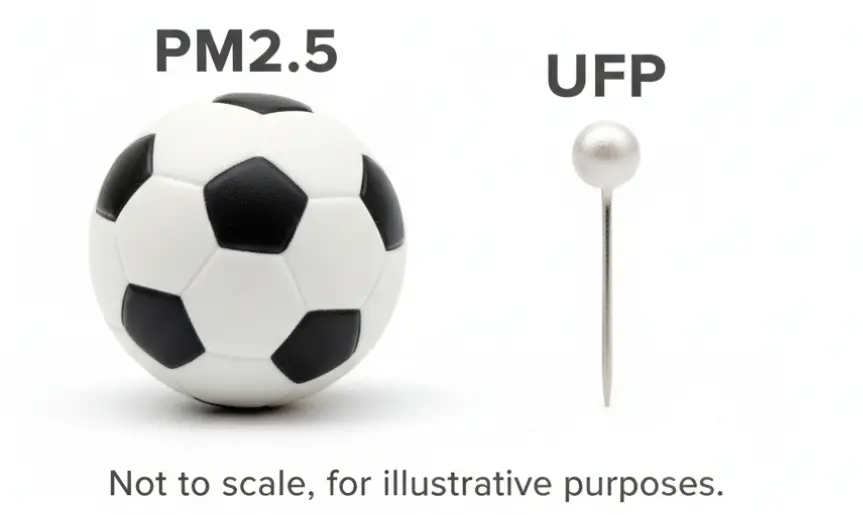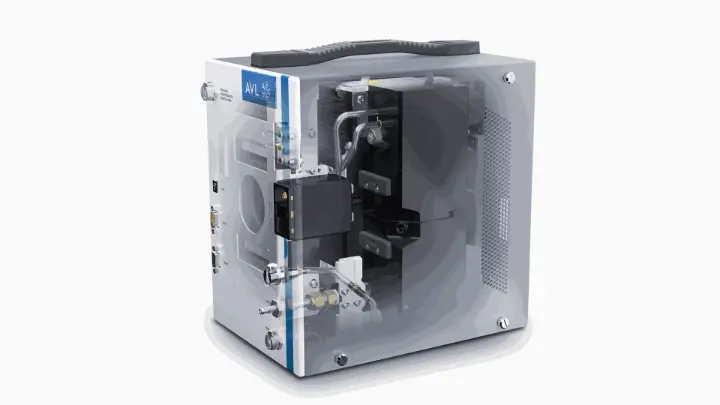Breathtakingly Invisible: Why Measuring Ultrafine Particles is Becoming the New Standard
Hey there, air quality, environmental, or safety professional. Let's talk for a moment about what we breathe. Not just the air in general, but those super-small, invisible particles that nobody really talks about. The particles that are so tiny they act like ninjas inside our bodies. We're talking about ultrafine particles (UFPs).
You can't see them, you can't smell them, but they're there. And they pose a growing concern for our health. Governments are now starting to take this seriously. Starting in 2026, monitoring these particles will become the new standard across Europe. The question is no longer if you need to measure, but how you're going to do it right.
Don't worry, you're not in this alone. We, at AAVOS, are here to guide you. And we have the perfect tool for the job: the AVL UltraFine Particle Monitor™ (UFPM). Think of this article as a friendly chat where we'll explain everything you need to know.
What Exactly Are Ultrafine Particles (UFPs)?
Imagine a human hair. Its diameter is already pretty small, right? Well, ultrafine particles are thousands of times smaller. We're talking about particles with a diameter of less than 100 nanometers. To put that in perspective: if a soccer ball were a normal fine dust particle (PM2.5), then a UFP would be the size of a pinhead.

Because of their minuscule size, they are the Houdinis of pollutants. Where larger particles are stopped by the natural filters in your nose and lungs, UFPs slip right through. They can penetrate deep into your alveoli, enter your bloodstream, and spread throughout your entire body, where they can cause inflammation and damage to organs like your heart and brain.
The message is clear: long-term exposure to UFPs can be a serious threat to public health. And that's why Europe has decided to tighten the reins.
The new EU Air Quality Directive 2024/2881
Change is in the air, literally and figuratively. The European Union has established the EU Air Quality Directive 2024/2881 which, for the first time, requires the monitoring of ultrafine particles (UFPs) across the EU as part of national monitoring strategies in combination with EN 16976 standard, which specifies exactly how the number concentration of ultrafine particles must be measured. It will be the guiding principle for air quality measurements across Europe.
What does this mean for you? Simply put: your old measurement equipment might not be sufficient anymore. You need an instrument that is not only accurate but also fully compliant with these strict new requirements. An instrument that is reliable, stable, and provides data you can build on.
This is where technology plays a crucial role.
For the accuracy and reliability that the new legislation demands, CPC technology according to EN 16976 is the only way to go. And that brings us to the champion in this category.
Meet the AVL UFPM: Your Reliable Partner in Air Quality
The AVL UltraFine Particle Monitor™ (UFPM) is not just another measuring device; it's the result of decades of experience in high-quality particle measurement. It is specifically designed to meet the strictest requirements, such as EN 16976 and ACTRIS compatibility.
But what truly makes the AVL UFPM better than the rest? Let's forget the specs for a moment and talk about what it means for you in practice.
Outstanding Reliability (No More Hassle):
The AVL UFPM is built with robust optical components and features automated drift detection. The result? Stable, reliable data you can truly count on, day in and day out.
Superior Ease of Use (Your Time is Valuable):
Nobody wants to deal with complex maintenance. Eg., replacing a part like the 'wick' (the sleeve that soaks up the butanol) is a time-consuming job that usually requires tools. With the AVL UFPM? No tools are necessary. It's designed for easy maintenance, so you can focus on what really matters: analyzing the data.
Smart, Autonomous Operation (It Thinks with You):
Imagine a power outage. The AVL UFPM has an automatic reboot function. It also features advanced error handling. This means fewer worries, less lost data, and more peace of mind.
Long, Uninterrupted Measurements:
With its 1.5-liter butanol bottle, the AVL UFPM can operate continuously for up to five weeks. This means fewer interruptions and a more efficient workflow.
In short, the AVL UFPM offers asmart and well-thought-out solution for the professional who demands robustness, reliability, and ease of use.

AAVOS: Your Local Expert in the Benelux
A fantastic instrument is one thing, but who helps you when you have questions? Who provides service, calibration, and expert advice? That would be us, AAVOS.
As the official distributor of AVL in Belgium, the Netherlands, and Luxembourg, we are more than just a supplier. We are your partner. We know the technology inside and out and understand the challenges you face. Whether you have questions about installation, data interpretation, or maintenance, our team of specialists is ready to help.
With AAVOS, you're not only choosing the best technology on the market but also the assurance of local support from a team that speaks your language.
Are You Ready for the Future of Air Quality Measurement?
The need to measure ultrafine particles accurately and reliably is no longer a distant future; it's tomorrow's reality.
Waiting is not an option. Preparing yourself with the right knowledge and the right equipment is the smartest move you can make. The AVL UltraFine Particle Monitor is the most robust, reliable, and user-friendly solution to meet the EN 16976 standard and take your air quality monitoring to the next level.
Are you ready to clear the air and face the future with confidence?
Contact AAVOS today for a no-obligation chat. We'd love to show you how the AVL UFPM can make a difference for your organization. Let's work together towards a healthier future.
Frequently Asked Questions (FAQ) about Ultrafine Particle Monitoring and the AVL UFPM
This FAQ addresses common questions about ultrafine particle monitoring, the upcoming European regulations, and the advantages of the AVL UltraFine Particle Monitor™ (AVL UFPM) and AAVOS.
General Questions about Ultrafine Particles (UFPs) and Regulations
Q1: What exactly are ultrafine particles (UFPs)?
A1: Ultrafine particles are tiny airborne particles with a diameter of less than 100 nanometers. They are thousands of times smaller than a human hair and are invisible to the naked eye. Their minute size allows them to penetrate deep into the human body.
Q2: Why are ultrafine particles a concern?
A2: Due to their extremely small size, UFPs can bypass the body's natural defense mechanisms, enter the bloodstream, and spread to various organs. Scientific research indicates that long-term exposure to UFPs can lead to inflammation and damage, posing a serious threat to public health.
Q3: What is the EU Air Quality Directive 2024/2881, and when does it become mandatory?
A3: The EU Air Quality Directive 2024/2881 introduces, for the first time, the monitoring of ultrafine particles (UFPs) across the EU as part of national monitoring strategies. It will become mandatory across Europe starting in 2026.
Q4: What does the 2026 deadline mean for my organization?
A4: The 2026 deadline signifies that existing air quality monitoring equipment might no longer be sufficient to meet the new legal requirements. Organizations will need accurate, reliable, and compliant instruments to measure UFPs according to the EN 16976 standard.
Questions about Measurement Technology
Q5: What is Diffusion Charging (DC), and why is it less suitable for meeting the regulatory compliance of the EU Air Quality Directive 2024/2881?
A5: Diffusion Charging (DC) measures the total electrical current produced when particles are charged. Its accuracy is dependent on the size and shape of the particles and it does not meet the requirements of EN 16976.
Q6: What is Condensation Particle Counting (CPC), and why is it considered the 'gold standard'?
A6: Condensation Particle Counting (CPC) is the preferred method and the technology behind the EN 16976 standard. CPC instruments make invisible UFPs grow by using butanol vapor as a condensing agent. The grown droplets are then large enough to be individually detected and counted by a laser, providing an exact count of the particles.
Questions about the AVL UltraFine Particle Monitor™ (UFPM)
Q7: Why AVL UFPM?
A7: The AVL UFPM is designed for superior reliability, ease of use, and intelligent operation. Key features including automated drift detection for stable data, tool-free maintenance, automatic reboot and advanced error handling functions, and extended continuous measurement periods.
Q8: How does the AVL UFPM ensure data reliability and prevent 'drift'?
A8: The AVL UFPM uses robust optical components and features an automated drift detection feature. This ensures consistent and accurate measurements over time.
Q9: Is the AVL UFPM easy to maintain?
A9: Yes, the AVL UFPM is designed for maximum ease of use. Maintenance tasks, such as replacing the butanol wick, require no tools, significantly simplifying the process and saving valuable time.
Q10: What happens if there's a power outage or error during operation?
A10: The AVL UFPM features an automatic reboot function, allowing it to resume operation without manual intervention after a power interruption. It also includes advanced error handling to minimize data loss and ensure continuous monitoring.
Q11: How long can the AVL UFPM operate continuously?
A11: The AVL UFPM can operate for up to five weeks continuously with its 1.5-liter butanol bottle, offering significantly longer uptime compared to many other instruments on the market.
Q12: Is the AVL UFPM compliant with international standards?
A12: Yes, the AVL UFPM is specifically designed to meet the strict requirements of the EN 16976 standard and is ACTRIS-compatible, ensuring it meets the highest international benchmarks.
Questions about AAVOS
Q13: What is AAVOS's role in relation to the AVL UFPM?
A13: AAVOS is the official distributor of AVL products, including the UFPM, in Belgium, the Netherlands, and Luxembourg (Benelux). We serve as your local partner for sales, installation, support, service, and expert advice.
Q14: What kind of support can I expect from AAVOS?
A14: AAVOS provides comprehensive local support, including assistance with installation, data interpretation, maintenance, and expert guidance. Our team of specialists is dedicated to ensuring you get the most out of your AVL UFPM and comply with new regulations.
Q15: Why should I choose AAVOS as my partner?
A15: By choosing AAVOS, you benefit from top-tier AVL technology combined with reliable, local expertise and support in the Benelux region. We offer peace of mind, knowing you have a dedicated partner to help you navigate the complexities of ultrafine particle monitoring.
Q16: How can I learn more or get started with the AVL UFPM?
A16: We encourage you to contact us directly for a no-obligation consultation. Our team will be happy to discuss your specific needs and demonstrate how the AVL UFPM can benefit your organization in meeting the upcoming regulatory demands.